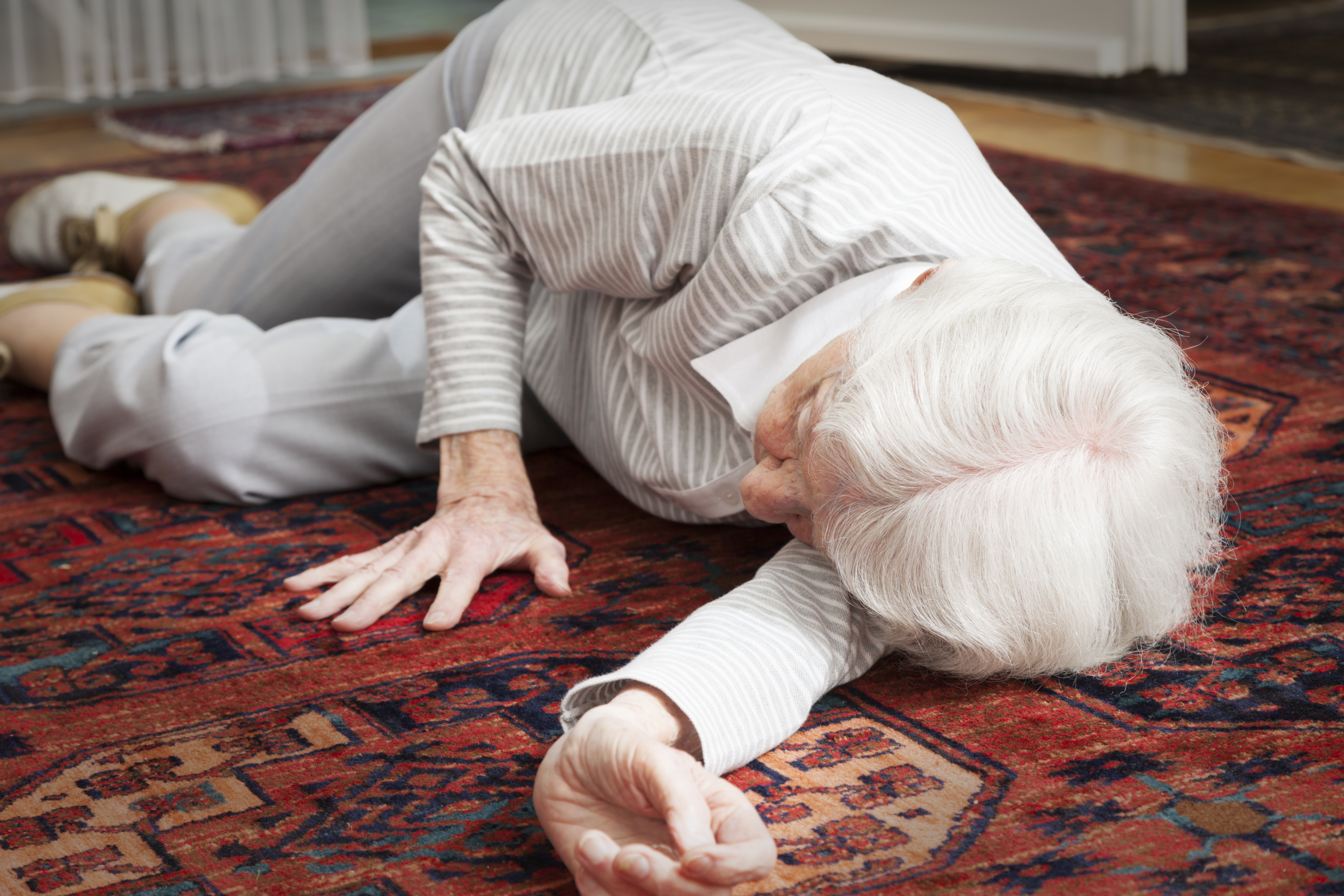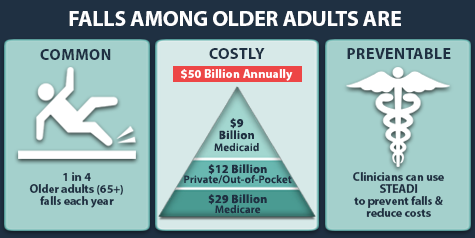Literature Review
Literature Review
(Literature Review)
Introduction
Falls are common in older adults, leading to serious injuries, including fractures and head injuries, and death in worst-case scenarios. Falls are also associated with disability and significant morbidity and mortality among older adults. Old age leads to overall poor physical and mental or cognitive status, which makes older adults prone to falls that cause physical injury and, in some instances, fear and psychological trauma. Statistically, a third of older adults experience at least one fall annually, while 10% fall multiple times yearly (Lloyd, 2021). Medical conditions increase the risk of falls, jeopardizing an older adult’s independence, and associated socioeconomic and personal consequences. Falls can occur at home or in any healthcare setting, including nursing homes. Hospitals are responsible for adopting interventions to minimize or prevent falls in older adults. Many interventions are adopted to prevent falls, including improving the environment and the terrain to make walking easy, providing non-slippery footwear, patient education, adequate lighting, installing handrails in hallways and bathrooms, and raising the bed to a comfortable height. This paper focuses on the role fall prevention interventions in reducing the risk factors of falls and associated effects among older adults. The primary themes addressed are; effects of falls on older adults, risk factors most frequently associated with falls in elderly patients, and impact of fall prevention programs on number of falls experienced by elderly patients. (Literature Review)

PICOT Question
Among older patients, do fall prevention interventions reduce the risk factors of falls and associated effects compared with no intervention? (Literature Review)
Primary Themes
Effects of Falls on Older Adults
Falls among older adults are one of the most prevalent and dangerous issues causing disabilities, physical injury, and cognitive impairment. Falls are directly correlated with mortality, morbidity, and decreased functionality. Falls are widespread among the elderly, kids, and athletes. Studies have indicated that a higher tendency to fall and, thus, a higher risk of injury is connected with medical comorbidities in the elderly (Appeadu & Bordoni, 2022). Falls are also linked to socioeconomic and personal effects, including direct and indirect healthcare costs such as paying for fall-related injury treatment and financial loss from the patient’s or the caregiver’s work absence to attend to the injury or impaired functionality. According to Appeadu and Bordoni (2022), the US incurs over $31 billion, which could rise to 74 billion by 2030, associated with falls among older adults 65 years and over. Conclusively, falls impact the patient and the healthcare system in multiple ways, including increasing healthcare costs, contributing to medical conditions, financial loss, and impaired functionality. Therefore, it is critical to prevent falls and reduce the risk of falls for hospitalized patients to promote their quality of care.
Falls lead to different injuries, including minor and major fractures and head injuries. Approximately 30%-50% are minor, 10% major injuries, and 1% hip fractures, with the last one increasing post-fall morbidity and mortality risk. Approximately 20% lead to serious injuries, including fractures in other body parts or head injuries. Studies have shown that, annually, fall-related injuries lead to over 800,000 hospitalizations, with 300,000 requiring hip fracture treatment (Vaishya & Vaish, 2020). Falls are estimated to be the leading cause of traumatic brain injury and associated deaths among older people aged 65 years and above. Repeated falls increase the risk of severe injury, hospitalization, and death because of frail body structures (Vaishya & Vaish, 2020). About half of the falls lead to an injury, with major ones including head injuries and fractures. Frailty rather than age determines the severity of an injury and associated consequences. In conclusion, falls cause different types of injuries that can lead to morbidity, disability, loss of function, and mortality among older adults. Therefore, preventing falls and their associated injuries is critical to promote patient safety and experience during their hospital stay. (Literature Review)

Risk Factors Most Frequently Associated with Falls in Older Patients
Inpatient falls, and fall-related injuries can be caused by various factors, including physical or cognitive impairments, environmental hazards, inadequate staff supervision, and age-related, such as hearing and vision impairment, vibration sensation and proprioceptive reduction, altered gait, and declining positional control. Age-related factors and changes do not cause falls directly but significantly contribute to most falls. Research shows that falls in older adults are also associated with physical diseases, medication side effects, cognitive deterioration, and environmental hazards (Vaishya & Vaish, 2020). According to Vaishya and Vaish (2020), environmental factors increase the risk of falling and can occur independently or interact with other factors, especially when postural control and mobility are needed, like walking on slippery and uneven surfaces. Maintaining balance becomes a problem as people age because of an impaired nervous system, which makes recovering balance challenging (Cuevas-Trisan, 2019). Furthermore, older age causes muscle weaknesses that make balancing and positioning difficult, leading to increased fall risk. Also, inadequate staffing or insufficient staff supervision can mean potential fall risks are not identified and addressed quickly enough (Vaishya & Vaish, 2020). In conclusion, inpatient falls, and fall-related injuries can be caused by a variety of factors, including physical or cognitive impairments, environmental hazards, and inadequate staff supervision. It is important to identify these potential causes to reduce the risk of falls and fall-related injuries. (Literature Review)
Impact of Fall Prevention Programs on Number of Falls Experienced by Older Patients
Falls prevention programs are implemented to reduce the risk of falls and fall-related injuries among hospitalized patients, especially older patients. There are many fall prevention programs, including patient education, hourly rounding, and medication management. Other interventions include reorganizing the Falls Committee, flagging high-risk patients, improving fall reports, increasing falls scrutiny, reorganizing leadership systems, standardizing fall prevention equipment, adapting to new hospital buildings, investigating root causes, and helping nurses think critically regarding risk. Additionally, falls prevention interventions can include alarms, fall risk identification, sitters, intentional rounding, patient education, physical restraints, environmental modifications, and non-slip socks. Studies indicate that fall prevention programs have varying effectiveness, but using several interventions at once increases the efficacy of fall prevention efforts. Based on research, patient education, medication management, and hourly rounding generate consistent fall prevention results and reduce risk factors associated with falls among older adults (Daniels, 2016; Mant et al., 2016; Goldsack, 2015; Walsh et al., 2018; LeLaurin & Shorr, 2019). In conclusion, there are many interventions to prevent fall risk, but with varying effectiveness. A nurse’s role is to conduct evidence-based research on various interventions and select the one with more benefits to the particular patient population. (Literature Review)
The following fall prevention interventions or programs are reviewed for their effectiveness in preventing risk factors of falls and associated effects among older adults:
Patient Education
Patient education helps influence patients towards the desired behavior and produces knowledge, attitude, and skills changes required to promote health and improve patient outcomes. Fall prevention education includes strategies such as increasing awareness of slippery surfaces, using equipment installed in hallways to aid walking, communicating with providers, and taking caution about medications that increase the risk of falling. Studies indicate that incorporating patient education into other fall prevention strategies helps reduce fall risks. Heng et al. (2020) explored the effectiveness of patient education in preventing falls among older adults. Findings indicate that direct face-to-face patient education, educational materials like handouts, pamphlets, brochures, hospital policies, procedures, and systems can help reduce falls and associated injuries. Fall prevention programs incorporating patient education reduce the risk of falling because patients are empowered and more aware of themselves and their surroundings. Heng et al. (2021) also explored patient education’s impact on fall rate and found that consistent, patient-centered education and small interactive groups helped prevent falls among hospitalized patients. Conclusively, patient education programs are effective in helping reduce the risk of falling among older adults, and studies recommend incorporating patient education into other fall prevention programs to increase effectiveness. (Literature Review)
Medication Management
Medication management includes strategies that engage patients and healthcare providers to establish a comprehensive, complete, and accurate medication list to help manage potential adverse events, side effects, and what to avoid to reduce the risk of complications. Hospitalized patients, particularly older adults, are under several medications, which increases the risk of medication-induced falls. Medication side effects that increase the risk of falling are often ignored when planning for fall prevention. Fall-risk-increasing drugs should be considered a significant risk factor during fall risk assessment in healthcare settings. About 47% of active substances used by inpatients increase the risk of falling because most affect the nervous and cardiovascular systems (Michalcova et al., 2020). Research shows that medication management can minimize side effects and interactions that contribute to falls. Michalcova et al. (2020) suggest adopting medication management programs such as preliminary categorizing fall-risk-increasing drugs (FRIDs) based on adverse drug effects to reduce fall risk. In support, Ming et al. (2021) report medication review as an effective approach to managing adverse drug reactions and enhancing drug safety among older patients to prevent falls and fall-related injuries among older adults. Medication review also helped reduce the severity of injuries and fall-related fractures (Ming et al.,2021). In conclusion, there are different medication management programs, including risk categorization of drugs according to their adverse effects and medication review of drugs that can help prevent medication-induced falls. Therefore, hospitals should increase awareness of medication-induced falls by adopting medication management programs to prevent falls and fall-related injuries. (Literature Review)
Hourly Rounding
Hourly rounding includes nurses and unlicensed assistive personnel conducting scheduled patient visits to perform interventions specific to or tailored to a particular hospitalized patient. Hourly rounding includes activities like nourishment, pain management, helping with elimination needs, range of motion, proper positioning, helping patients with applicable musculoskeletal needs, and room observation to ensure proper and adequate lighting, call bell and phone are within reach, medical equipment is functioning as expected, and walking areas or hallways are clutter-free (Shepard, 2015). Studies indicate that hourly rounding generates consistent fall prevention results and reduces risk factors contributing to falls and associated effects among older adults (Daniels, 2016; Mant et al., 2016; Goldsack, 2015; Walsh et al., 2018; LeLaurin & Shorr, 2019). According to Daniels (2016), purposeful and timely hourly rounding is effective in helping meet patient needs consistently, ensuring patient safety, lowering preventable events, and proactively addressing patient problems. Mant et al. (2016) also found that implementing hourly rounding effectively prevents fall-related incidents among older patients in acute care settings. Goldsack (2015) further supports this after finding in a pilot test that fall rate was considerably lower, at 1.3 falls/1,000 patient days after implementing hourly rounding during the test period. Furthermore, Walsh et al. (2018) found that when nurses began addressing fall risk during hourly rounds, the fall rate significantly declined, implying hourly rounds’ effectiveness in reducing fall risk among inpatients. Consistently, Manges et al. (2020) found that hourly rounding improved care quality, patient satisfaction, and patient empowerment and helped decrease patient fall rates. In conclusion, hourly rounding is an effective approach to preventing falls among older patients. Therefore, hospitals and nurse leadership should implement intentional and purposeful hourly rounding to reduce risk factors contributing to falls in older adults and associated effects such as disability, loss of independence, and increased healthcare costs due to injury treatment. (Literature Review)
Others Interventions
Besides patient education, medication management, and hourly rounding, other fall prevention interventions can be adopted to help reduce the risk of falling among older adults. These interventions include reorganizing the Falls Committee, flagging high-risk patients, improving fall reports, increasing falls scrutiny, reorganizing leadership systems, standardizing fall prevention equipment, adapting to the new hospital building, investigating root causes, educating patients, and helping nurses think critically regarding risk in reducing patient falls. Walsh et al. (2018) found that implementing these interventions incrementally reduced the fall rate from 3.07 to 2.22 per 1000 patient days and injury rate from 0.77 to 0.65 per 1000 patient days. LeLaurin & Shorr (2019) investigated the effectiveness of alarms, fall risk identification, sitters, intentional rounding, patient education, physical restraints, environmental modifications, and non-slip socks and found that these interventions, coupled with intentional rounding, enhanced patient satisfaction and minimized patient harm. However, these studies indicate that other interventions have moderate effects on fall prevention, associated injuries, morbidity, and mortality and should not be implemented as stand-alone interventions. In conclusion, multiple fall prevention programs are implemented in hospitals, but research shows most fall prevention programs have moderate effects on fall prevention. Therefore, hospitals should consider adopting various interventions to increase the effectiveness of fall prevention efforts in healthcare settings. (Literature Review)
Conclusion
Patient falls are a significant problem in US hospitals, especially among older adults at increased risk of falling due to age-related factors, environmental factors, medical conditions, and frail bodies. Falls lead to injuries and contribute considerably to subsequent morbidity and mortality among hospitalized patients. Many interventions currently used to prevent falls indicate moderate benefits and unknown sustainability. Reviewed articles provide consistent results showing patient education, medication management, and hourly rounding as effective in reducing the risk of patient falls and associated effects, promoting patient safety, and improving patient experience, outcome, and satisfaction. (Literature Review)
References
Appeadu, M. K., & Bordoni, B. (2022). Falls and fall prevention in the elderly. In StatPearls [Internet]. StatPearls Publishing.
Cuevas-Trisan, R. (2019). Balance problems and fall risks in the elderly. Clinics in geriatric medicine, 35(2), 173-183.
Daniels J. F. (2016). Purposeful and timely nursing rounds: a best practice implementation project. JBI database of systematic reviews and implementation reports, 14(1), 248–267. https://doi.org/10.11124/jbisrir-2016-2537
Goldsack, J., Bergey, M., Mascioli, S., & Cunningham, J. (2015). Hourly rounding and patient falls: what factors boost success?. Nursing, 45(2), 25–30. https://doi.org/10.1097/01.NURSE.0000459798.79840.95
Heng, H., Jazayeri, D., Shaw, L., Kiegaldie, D., Hill, A. M., & Morris, M. E. (2020). Hospital falls prevention with patient education: a scoping review. BMC geriatrics, 20(1), 140. https://doi.org/10.1186/s12877-020-01515-w
Heng, H., Slade, S. C., Jazayeri, D., Jones, C., Hill, A. M., Kiegaldie, D., Shorr, R. I., & Morris, M. E. (2021). Patient Perspectives on Hospital Falls Prevention Education. Frontiers in public health, 9, 592440. https://doi.org/10.3389/fpubh.2021.592440
LeLaurin, J. H., & Shorr, R. I. (2019). Preventing Falls in Hospitalized Patients: State of the Science. Clinics in geriatric medicine, 35(2), 273–283. https://doi.org/10.1016/j.cger.2019.01.007
Lloyd, S. L. (2021). Hourly rounding to reduce patient falls – A quality improvement project. University of Texas.
Manges, M. E., Zuver, M. C., Mack, K., & Abraham, S. P. (2020). hourly rounding and medical-surgical patient falls: A review of the literature. International Journal of Science and Research Methodology.
Mant, T., Dunning, T., & Hutchinson, A. (2016). The clinical effectiveness of hourly rounding on fall-related incidents involving adult patients in an acute care setting: a systematic review. JBI Evidence Synthesis, 10(56), 1-12.
Michalcova, J., Vasut, K., Airaksinen, M., & Bielakova, K. (2020). Inclusion of medication-related fall risk in fall risk assessment tool in geriatric care units. BMC geriatrics, 20(1), 1-11.
Ming, Y., Zecevic, A. A., Hunter, S. W., Miao, W., & Tirona, R. G. (2021). Medication Review in Preventing Older Adults’ Fall-Related Injury: a Systematic Review & Meta-Analysis. Canadian geriatrics journal : CGJ, 24(3), 237–250. https://doi.org/10.5770/cgj.24.478
Shepard, L. H. (2015). Stop going in circles! Break the barriers to hourly rounding. Nursing management, 44(2), 13-15.
Vaishya, R., & Vaish, A. (2020). Falls in Older Adults are Serious. Indian journal of orthopaedics, 54(1), 69–74. https://doi.org/10.1007/s43465-019-00037-x
Walsh, C. M., Liang, L. J., Grogan, T., Coles, C., McNair, N., & Nuckols, T. K. (2018). Temporal Trends in Fall Rates with the Implementation of a Multifaceted Fall Prevention Program: Persistence Pays Off. Joint Commission journal on quality and patient safety, 44(2), 75–83. https://doi.org/10.1016/j.jcjq.2017.08.009



